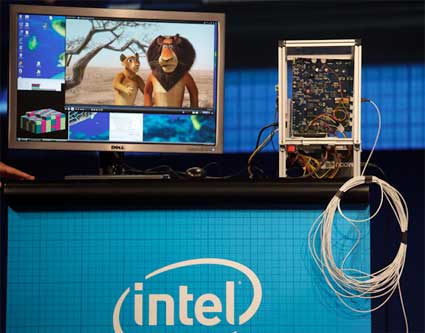There's probably a very good reason why Intel is trying to stall chipset support for USB 3.0, they'd like it much more if they could control the market with their own patents and licenses. But that doesn't mean they have something really interesting in their hands though.
Intel unveiled Light Peak technology, with which they hope to ultimately replace the profusion of different cables sprouting from today's PCs with a single type of fiber-optic link.
"We hope to see one single cable," Perlmutter said, adding that one thing getting in the way of smaller laptops is the profusion of cable ports around the systems' edges.
This prototype PC has the Light Peak controller and optical connector that sends signals down a single white optical cable. It will reach 100 gigabits per second in the next decade, said Jason Ziller, Intel's director of optical input-ouput program office, in an interview. The company envisions Light Peak as a replacement for the cables that currently lead to monitors, external drives, scanners, and just about anything else that plugs in to a computer. A PC could have a number of Light Peak ports for different devices, or a connection could lead to a hub--perhaps an external monitor--with multiple connections of its own, Ziller said. It's not clear how much the technology will cost or how many years it will take to become mainstream. And wireless communication technology--Intel itself has promoted Ultra-Wideband (UWB) for years--offers the attraction of getting rid of some cables altogether.
The Light Peak technology handles multiple communication protocols at the same time, with quality-of-service provisions to ensure high-priority traffic such as video get preferred treatment, he said.
Intel's Dadi Perlmutter traces the Light Peak cable from a PC to a monitor on the other side of the stage. Light Peak can traverse distances up to 100 meters. The cables themselves are durable, Ziller said: "You can tie a knot in it and it'll still work." Intel has a lot of clout in the computing marketplace, but building support for a radical new connection that could replace DVI, DisplayPort, USB, Firewire, HDMI, and any number of other connections would require broad industry support. Intel's taking the usual approach to tackling that problem:
"We're working with the industry to standardize it," Ziller said. Intel has been briefing other companies for "the last few months," and now is trying to get the standards process started in earnest with partners including companies in the computing, consumer electronics, and telephone handset markets, he said. Ziller wouldn't say who else is participating in the effort, but Intel published a statement of support from Sony, which has a lot of clout of its own in many markets. "Sony is excited about the potential for Light Peak technology that Intel has been developing, and believe it could enable a new generation of high-speed device connectivity," said Ryosuke Akahane, vice president of Sony's Vaio Business Group.
So will Light Peak become a universal port? "Intel's long-term vision is you could get to that," Ziller said.

